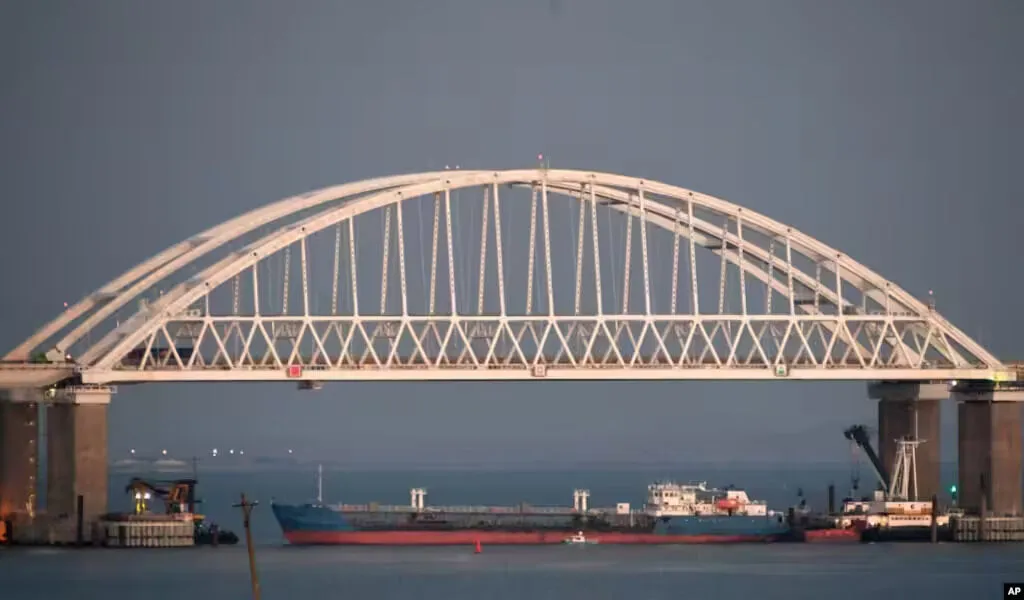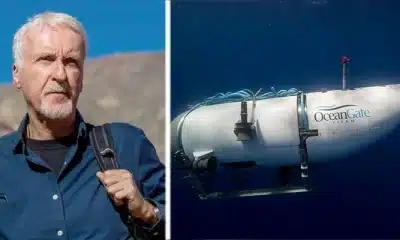World
OceanGate Employee Pushes Back Against Idea Of ‘Desperation’ To Complete Missions

A key employee of the business that owned the experimental submersible that exploded en route to the Titanic ruins rebuffed a Coast Guard investigator’s question about whether OceanGate felt a sense of “desperation” to complete the dives due to the expensive cost.
Amber Bay, head of administration for the firm that owned the deadly Titan submarine, emphasized on Tuesday that the company would not “conduct risky dives just to meet a need.”
However, she agreed that the corporation wanted to deliver for individuals who paid $250,000 and were urged to work as “mission specialists.”
“There definitely was an urgency to deliver on what we had offered and a dedication and perseverance towards that goal,” she told the Coast Guard’s panel.
OceanGate Employee Pushes Back Against Idea Of ‘Desperation’ To Complete Missions
Stockton Rush, the co-founder of OceanGate, was one among five persons killed when the submersible imploded in June 2023.
The Coast Guard held a public hearing earlier this month as part of a high-level investigation into the causes of the implosion. Some of the testimony focused on the company’s troubles.
On Tuesday, Bay disputed previous evidence from Antonella Wilby, a former OceanGate contractor who claimed Bay told her “you don’t seem to have an explorer mindset” after she voiced safety concerns. Bay stated that Wilby’s concerns were taken into consideration and treated with respect at the time. Bay clarified that her own responsibilities did not include engineering or operations.
She later burst into tears while recounting the tragedy, which was personal because she knew the victims.
“I had the privilege of knowing the explorers whose lives were lost,” Bay stated through tears. “And there’s not a day that passes that I don’t think of them, their families and the loss.”
Earlier in the hearings, former OceanGate operations director David Lochridge stated that he frequently battled with Rush and believed the corporation was solely focused on making money. “The whole idea behind the company was to make money,” Lochridge stated. “There was very little in the way of science.”
Lochridge and other earlier witnesses described a corporation that was eager to get its unconventionally designed vessel into the sea. The catastrophe sparked a global discussion over the future of private undersea exploration.
Karl Stanley, a submersible pilot and designer of the Roatan Institute of Deepsea Exploration, testified on Tuesday to provide insight into deep-sea submersible operations and safety. He claimed that “billionaires courting scientists” have disrupted the industry’s economy.
Stanley also believed OceanGate’s characterization of paid passengers as “mission specialists” was an attempt to dodge accountability.
Furthermore, the company’s “entire business plan made zero sense,” Stanley stated. He also stated that he believed the implosion was caused by Rush’s drive to leave his mark in history.
“There was nothing unexpected about it. “Everyone with a little bit of information expected this,” Stanley explained.
The session is anticipated to last until Friday and will feature numerous additional witnesses, some of whom were closely tied to the company.
Guillermo Sohnlein, a businessman who co-founded OceanGate with Rush, said during evidence Monday that he believed the accident would spark a renewed interest in exploration, especially the world’s deepest waters.
“This cannot be the end of deep-sea exploration. This cannot be the end of deep-diving submersibles, and I don’t think it will be,” he said.
At the opening of the hearing, Coast Guard officials stated that the submersible had not been independently reviewed, which is typical protocol. That, together with Titan’s unconventional design, drew scrutiny from the submarine exploration community.
OceanGate Employee Pushes Back Against Idea Of ‘Desperation’ To Complete Missions
OceanGate, situated in Washington state, halted operations following the implosion. The company currently has no full-time employees, although it was represented by an attorney at the hearing.
During the submersible’s final dive on June 18, 2023, the crew lost touch after exchanging SMS about Titan’s depth and weight while plummeting. The support ship Polar Prince then sent Titan several communications enquiring if he could still see the ship on its onboard display.
When the submersible became overdue, rescuers dispatched ships, planes, and other equipment to a location around 435 miles (700 km) south of St. John’s, Newfoundland. The Titanic’s wreckage was later discovered on the ocean floor about 330 yards (300 meters) off the bow, according to Coast Guard officers. Nobody on board survived.
OceanGate stated that it has been fully participating with the Coast Guard and NTSB investigations since they began. Titan had been making excursions to the Titanic crash site since 2021.
SOURCE | AP
World
Do Microplastics in the Atmosphere Endanger Your Fertility?

(VOR News) – It is quite possible that the presence of small microplastic particles in the air may be a contributing factor to a wide variety of health problems, including malignancies of the lungs and colon.
This is something that needs additional research to be determined. There is one more item to take into consideration, and that is the potential that this is the exact circumstance.
A recent study found that tires and debris that are decomposing shed minute fragments of plastic that go airborne, so creating a form of air pollution that is not particularly widely known. This type of pollution is caused by the degradation of plastic. An example of this type of pollution is that which is discharged into the atmosphere.
The industry refers to microplastic as “air pollution.”
According to the findings of a researcher named Tracey Woodruff, who is a professor of obstetrics, gynaecology, and reproductive sciences at the University of California, San Francisco, “These microplastics are basically particulate matter from air pollution,” and it is common knowledge that this particular type of air pollution is particularly hazardous.
The researchers who supplied background notes stated that the size of microplastics is less than 5 millimetres, which is smaller than a grain of rice.
This information was provided, according to researchers. These details were supplied by the researchers who conducted the study. These particulars were provided by researchers who were responsible for carrying out the study.
The amount of plastic that is created on a yearly basis by enterprises all over the world is roughly 460 million tonnes, as indicated by the data that were provided by academics all over the world. The forecasts indicate that by the year 2050, this quantity is anticipated to have increased to 1.1 billion tonnes.
Driving is a substantial contributor to the amount of plastic that is floating around in the atmosphere, according to the conclusions of the experts who conducted the study about the phenomenon. When tires are worn down to the point where they scrape against the surface of the road, they allow microplastics to be released into the environment.
As a result of the tires wearing down, this occurs. This impact is brought about as a consequence of the inevitable amount of wear and tear that tires are subjected to.
A study that was published on December 18 in the journal Environmental Science & Technology was the result of researchers conducting an examination of data collected from over 3,000 previous investigations.
The paper was published as a consequence of this procedure. The review was constructed with the help of this analysis that was carried out.
Microplastic used this analysis to put together the review.
A number of diseases, such as cancer, lung problems, and infertility, may be influenced by the presence of microplastics in the air, according to the data, which led to the conclusion that this may be the case.
Despite the fact that the vast majority of the studies that were incorporated into the study were carried out on animals, the researchers claimed that it is very certainly plausible that the findings can also be applied to people. The fact that the majority of investigations were conducted on animals does not change the reality that this is the case.
“We urge regulatory agencies and policy leaders to consider the growing evidence of health harms from microplastics, including colon and lung cancer,” stated Nicholas Chartres, the principal investigator and senior research fellow at the University of Sydney.
The organisation reported this comment. The University of California, San Francisco (UCSF) issued a press release on behalf of the organisation that contained this statement. The news release was disseminated to the public. We are convinced that state officials will act quickly to make sure that no leaks of this kind occur, which is of the highest importance.
SOURCE: USN
SEE ALSO:
Justin Trudeau’s Fight for Gender Equity in Canada
Liberal MPs Call on Trudeau to Resign
World
Russian Oil Ships In The Kerch Strait Are Undergoing Rescue Operations.

(VOR News) – Following Sunday’s powerful storm, a Russian oil tanker carrying hundreds of tonnes of oil products ultimately broke apart, causing an oil spill into the Kerch Strait below. Additionally, Russian officials reported that the damage was causing problems for another vessel.
Sunday, Russian authorities announced an emergency rescue operation.
According to the Russian state news agency TASS, which claimed the Emergency Situations Ministry as its source, the Volgoneft-212 tanker, carrying fuel oil and carrying thirteen crew members, ran aground and suffered damage to its bow. A shipment of fuel oil was being transported by the tanker.
Authorities have told the public that the damage was brought on by the extreme weather conditions that are currently occurring.
A second tanker, the Volgoneft-239, was damaged during the storm and is currently stranded in the same area with 14 crew members on board, according to the Ministry of Emergency Situations. The tanker was discovered abandoned and alone in the same spot.
Additional tankers also suffered damage. The 132-meter-long cruiser, which was constructed in 1973, hangs the Russian flag around its neck.
The footage posted by state media showed the 136-meter Volgoneft-212 tanker, which was cut in two with its bow underwater, and waves crashing over its deck. At least one person lost his life as a result of this tragedy. This led to the opening of two distinct criminal investigations by the Russian authorities to look into potential violations of certain safety regulations.
Having flown the Russian flag since 1969, the yacht was finished.
Rosmorrechflot, the Russian government agency in charge of water transportation, reported a petroleum product spill.
It is believed that the cargo capacity of each tanker is around 4,200 tonnes of oil products.
The magnitude of the leak and the cause of the substantial damage one of the tankers received were not specified in the official remarks. This is in accordance with the official remarks.
Several news sites cited Kremlin spokesperson Dmitry Peskov as saying that President Vladimir Putin directed the formation of a working committee to handle the rescue effort and lessen the effects of the oil disaster.
Peskov recommended that the government appoint the working committee’s members. This comment was made public right after Putin met with the ministries responsible for ecology and disaster management.
The Russian government has said that it will be sending more than fifty individuals and pieces of equipment to the area in response to the current crisis. Mi-8 helicopters and rescue tugboats are examples of these people and tools.
The news that experts are presently investigating the damage at the event site was announced by Svetlana Radionova, who is in charge of Rosprirodnadzor, Russia’s natural resources regulating entity.
Kommersant reports that Volgoneft-212 used 4,300 tonnes of fuel oil.
The footage, which showed a partially submerged ship and murky water on rough seas, was posted to Telegram without the owner’s consent.
The warships were located in the Kerch Strait, which separates Crimea from the Russian mainland, when the distress signals were sent out.
The Kerch Strait is a crucial international marine passage that connects the Black Sea with the Sea of Azov, allowing for easier traffic between the two bodies of water. It also acts as a border between Russia and the Crimean Peninsula, which is under Russian occupation. The Kerch Strait is located in the centre of the two nations.
The peninsula has remained a major source of contention between the two national governments ever since Russia annexed it from Ukraine in 2014. Russia was the one who seized the peninsula. Ukraine brought legal action against Russia before the Permanent Court of Arbitration in 2016.
Specifically, the lawsuit claimed that Russia intended to illegally take over a location. The argument was supported by evidence pertaining to Russia’s conduct in the region. In 2021, the Russian Federation closed the strait for several consecutive months
SOURCE: VN
SEE ALSO:
Indian Students Studying in Canada Fret Over Visa Scrutiny
Trudeau Sparks Anger After Labeling Trump Voters “Misogynists”
World
Japan List Cannabis as Narcotic Criminalizes Recreational Use

TOKYO – Japan updated its cannabis and narcotics control legislation on Thursday, criminalizing cannabis (Marijuana) use and tetrahydrocannabinol (THC), imposing a maximum seven-year prison sentence.
While the possession, transmission, and cultivation of cannabis and THC were already prohibited in Japan, the new rules will classify them as narcotics and criminalize their use as well, with a prison sentence of up to seven years for violations.
The amended regulations also legalize medical items containing cannabis-derived compounds that are beneficial and safe.
In 2019, 1.8 percent of the Japanese population had used cannabis at least once, making it the country’s second most popular illicit substance behind methamphetamine.
In 2023, a record 6,703 people were probed in cannabis-related criminal cases in Japan, topping methamphetamine cases for the first time, according to the Health, Labour, and Welfare Ministry. Seventy percent of instances involved people under the age of thirty.
A nationwide poll performed the same year by the ministry’s research group estimated that approximately 200,000 people had consumed marijuana within the previous year.
Japan previously did not penalize cannabis usage, apparently taking into account farmers who may have accidentally ingested the drug while producing cannabis plants for use in hemp products.
The amendments will also lift a restriction on cannabis-derived medicines, putting them under a licensing system similar to other drugs used for pain relief and other purposes.
Drugs derived from cannabis plants were only allowed in clinical studies in Japan, but patient groups have been advocating for access to cannabis-derived cannabidiol treatments already licensed in Europe and the United States for illnesses like severe epilepsy.
Cannabis cultivation dates back to the Jōmon period of Japanese prehistory, roughly six to ten thousand years ago (source: Wikipedia).
Cannabis hemp, as one of Japan’s first cultivated plants, provided an essential supply of plant fibre for clothing, cordage, and Shinto ritual goods, among other uses.
For much of Japanese history, hemp was common for fabric and food before cotton emerged as the country’s dominant fibre crop during industrialization during the Meiji period.
Following the end of World War II and the occupation of Japan, the Cannabis Control Law prohibited cannabis possession and manufacturing.
Related News:
Japan’s Mount Fuji Implements Tourist Tax In Response To Overcrowding Concerns
Germans Celebrate As Recreational Cannabis Use Becomes Legal
-
Politics4 weeks ago
Miller Expects 4.9 Million Foreigners to Leave Canada Voluntarily
-
News3 weeks ago
Nolinor Boeing 737 Crash Lands in Montreal
-
News2 weeks ago
“Shocking Video” Vancouver Police Shoot Armed Suspect 10 Times
-
Tech3 weeks ago
Increasing its Stake in OpenAI by $1.5 Billion is a Possibility for SoftBank.
-
News4 weeks ago
Facebook Securities Fraud Case Dropped
-
Health4 weeks ago
A Canadian Teenager’s Bird Flu Virus Has Mutations
























